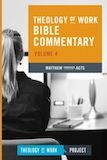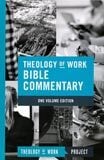Mark 1:29–39. Rhythms of Work and Rest
Bible Commentary / Produced by TOW Project
A Thousand Points of Very Painful LightJennifer Woodruff Tait describes functioning in the modern workplace as an autistic person. “I’ve often described it to people as though I’m reaching down into myself to get the words to talk to you with. I am, most of the time, fairly verbal (I edit a magazine, for goodness sake), but I’m starting to realize that I go semiverbal a lot more than I realized. Just let the room be too hot or too cold, or there be a TV in the background, or too much of my energy going into looking at your face instead of the ceiling (WHO INVENTED EYE CONTACT???), and I lose words. Sometimes all of them. Sometimes you ask me to repeat something, and I have to send that backhoe down into my psyche AGAIN and bring up the words AGAIN, and I just want to go crazy and collapse. I often wonder if those of us autistics who are completely nonverbal just can’t get the backhoe to go down far enough. There’s a reason autistic people are known for repeating things, memorizing things, and responding to situations with stock phrases (and, I would add, why so many of us love formal liturgy). Do you know what a relief it is when somebody’s already done the excavation with the backhoe? And the other thing is: nothing helps. Well, there are things that help me suppress the pseudolinguistic geometry, or temporarily redirect it, so I don’t interfere with the flow of neurotypical conversation. But doing those things comes at tremendous cost.” —from “A Thousand Points of Very Painful Light” by Jennifer Woodruff Tait at Patheos.com |
After healing a person in the synagogue, Jesus goes directly to Simon and Andrew’s home and heals Simon’s mother-in-law. Her immediate response is to work, providing hospitality in an act of service. Service is always an appropriate response to an encounter with the love of Jesus.
Jesus’ healing in this episode occurs through personal touch. “He took her hand” (Mark 1:31). Physical touch conveys powerful connection. The touch of a human being may be a power for good or for evil. The touch of Jesus is always a power for good. In the midst of a very busy schedule, Jesus takes the time to reach out to one person who needs him. At work, there may be people we could serve if only we took the time to connect with them in some manner. Instead of striving for time only with the powerful, the well connected, the strong, and those able to advance your agenda, what if you found time to connect with the overlooked, the low in status, the needy, and the unheralded? Physical touch may not be necessary, or appropriate, in every situation, but the attention of one person to another—when it is employed for good, rather than domination—is an act in the imitation of Christ.
When the sun falls, the Sabbath is over, and crowds come to Jesus for healing. He heals them but tries to it keep it quiet (Mark 1:34). Fame is not his purpose, but compassion, and he casts out spirits, cures the sick, and makes the unclean clean.
From the Field: Work and Home BoundariesThe Internet enables people to play games at work. At the same time, it enables people to work at home. Have you thought about policy related to this boundary blurring between home and work? Here at Cisco we are all very busy, and when people are so busy they tend to police themselves. If somebody comes in and takes advantage of the company, they are likely to end up turning themselves in and saying, “I can’t do this anymore.” On the other side, I do worry that some people will become workaholics. When I hire people, I tell them that there will be spurts when you’re going to have to give me seven days a week for a couple of weeks—but if that becomes your pattern, something is wrong. I’ve either given you the wrong responsibility or you are inept at managing your time. There is absolutely no way I expect you to do that all the time. I believe very strongly that if you’re doing the right things in your home and you’re balanced, you’re going to be productive here. I have yet to see a human being that can put in ninety productive hours in a week. At the end of a long day, it may take you forty minutes to write one more letter to a client before you go home—but the next morning it takes two minutes. God didn’t intend us to work these hours, and I’m not going to be party to somebody becoming a workaholic; when somebody tells me that, I don’t reward it. - From an interview with Gary Daichendt, formerly of Cisco Systems in San Jose, California, USA. |
From the Field: Prayer and WorkAnomi Bruynius is a business owner and asset manager and has a unique way of incorporating prayer and consulting God in her work. She often works in male-dominated environments and has learned to see God as her silent partner. “So when I am faced with difficult negotiations, I say that I need to consult with my silent partner, and that I will get back to them with my decision. I can see from their faces that they are all thinking, ‘Knew it, she’s not the boss. There is a man in charge.’ And yes, there is a man in charge, God is in charge, he is my silent partner.” See an extended testimony from Anomi at a conference at Malyon College, Queensland, Australia. Matthew Johnson is finance director of an education software business serving over 3,000 schools across Australia and Southeast Asia. His job has a large responsibility for leading the financial direction of the business, and he has very busy days. Challenged to consider spiritual practices in his working, Matthew started setting an alarm on his phone at 10:30 a.m. and 2:30 p.m., the busiest moments of his day, to remind himself to pray. He describes what has happened since he started that practice: “The practice has enabled me to better observe God in action. Amongst the chaos of a normal day, I am normally distracted by the busyness. The 2 mins to breathe, look around, reflect on my meetings that day helps me to re-centre on that narrative that God is constantly at work, and I get the opportunity to get a glimpse of Him and even co-create with Him. As a result I feel like I better experience His grace and presence.” - As told to Kara Martin, TOW Board member |
The next day, Jesus rises to pray while it is still very dark (Mark 1:35). As well as the weekly Sabbath rhythm of work and rest that we saw in Mark 1:21–28, Jesus establishes a daily rhythm. After a long period of work or before a major decision, Jesus withdraws to a solitary place, for stillness with God and to pray. His prayer is not a public performance, but a matter of personal communion with the Father. In this case, after Jesus spends time in prayer, he recognizes it is time to go to another village, even though he is in great demand where he is (Mark 1:37–38). The routine work may sometimes obscure the need to make a change. Your ability to please those you know may keep you from finding where you can make the most difference. Prayer can give you the time, space, and guidance to recognize your true path.
Daily prayer seems to be a very difficult practice for many Christians, perhaps nearly everyone. Between home responsibilities, long commutes, early working hours, a desire to get ahead of the day’s responsibilities, and late nights spent on unfinished work (or entertainment), it seems almost impossible to establish a consistent routine of prayer.
Jesus does not speak judgment against people who do not or cannot pray daily about the work that lies ahead of them. But he himself—though busier than anyone around him—does pray constantly about the work and the people God sets before him.
Regular time set apart is good, but it is not the only way to pray. Prayer can be simply a conversation with God—ideally an ongoing dialogue throughout the day. If you have any moments free for your own thoughts while at work, you have opportunities for prayer. Prayer involves listening as much as talking. Taking a moment to be still and silent before the Lord during the workday is as much prayer as is stating petitions, praise, and thanks.
One practice many have found helpful is to pray briefly at multiple times during the day. “Daily Devotions for Individuals and Families,” found in the Book of Common Prayer, pages 136–43 (available online here), provides brief structures for prayer in the morning, at noon, in the evening, and at night. The TOW Project also offers an online devotional, “How to Pray for Your Work.” Even briefer examples include
- a one- or two-sentence prayer when moving from one task to another;
- praying with eyes open;
- offering thanks silently or out loud before meals; and
- keeping an object or verse of Scripture in a pocket as a reminder to pray.
Among many books that can help establish a daily prayer rhythm are Finding God in the Fast Lane by Joyce Huggett, The Spirit of the Disciplines by Dallas Willard, and Working in the Presence of God: Spiritual Practices for Everyday Work
by Denise Daniels and Shannon Vandewarker.[1]







